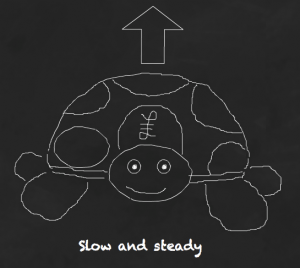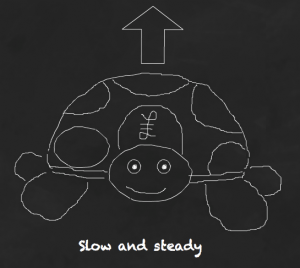After getting clobbered for a couple of quarters, our Slow & Steady portfolio has been buoyed up by the new mood of… well, if not optimism, then at least relief that we haven’t been dragged over the abyss by a wounded Europe.
Since we last tuned in:
- The daily doom-mongering over Greece and Italy has faded from the headlines.
- The ECB’s massive money injection into European banks has bought time.
- America has been cheered by a regular flow of positive indicators.
- And (perhaps) recession has been averted (just) in Britain.
All of which has turned last quarter’s 1.70% loss into a 4.69% gain.
Reminder: The Slow and Steady portfolio is Monevator’s model passive investing portfolio. It was set up at the start of 2011 with £3,000. An extra £750 is invested every quarter into a diversified set of index funds, heavily tilted towards equities.
You can read the original story and catch up on all the previous passive portfolio posts here.
Feeling peaky
Here we are then in the second year of our portfolio’s existence. Time flies when you’re compounding interest!
In the first year of its existence, the Slow & Steady portfolio didn’t post a gain higher than the 0.85% we registered in Q2. Indeed, by Q3 we were 9.32% down.
So the new peak hit in Q1 2012 represents a heady moment for our dogged little portfolio. The psychological impact of seeing our numbers turn green is extraordinary, even though the £281.62 we’ve made would scarcely fund a weekend’s jaunt to Tenby.
The human brain just loves a win. We should bear in mind though that if this rally runs out of steam we’ll be heading downward soon enough, and any success so far is born on the back of buying cheap stocks when things are looking dire.
The equity markets that we invest in have risen together over the past three months, and as the Slow & Steady portfolio is aggressively tilted towards equities (78%) their fate is largely our fate.
The US is the powerhouse driving much of the growth, as ever, which shows the benefit of aligning your portfolio with the global market as opposed to trying to predict the future shape of geopolitics using your Risk board.
Our gilt position has slid back a smidge from last quarter (but only a smidge), just as we should expect when the doomsday clock pauses for a few secs. Fixed income still accounts for much of the growth to-date in the portfolio – a sharp contrast to Japan, which has brought in 11p so far.
In other heartening news: we earned some dividends!
Remember that the Slow & Steady portfolio is entirely invested in accumulation funds, which don’t even give us a glimpse of our silver. Instead, these funds automatically use the dividends we earn to buy more shares, so we benefit from the compounding of our wealth over time.
Last quarter’s dividends brought in:
- FTSE All-Share Index: £16.02
- All Stocks Gilts Index: £12.78
New purchases
Every quarter we feed another £750 into the dream-maker / money mincer. The portfolio is still sufficiently small for our rebalancing chores to be achieved via this new cash.
UK equity
HSBC FTSE All Share Index – TER 0.27%
Fund identifier: GB0000438233
New purchase: £138.38
Buy 39.3898 units @ 351.3p
Target allocation: 19%
Developed World ex UK equities
Split between four funds covering North America, Europe, the developed Pacific and Japan.
Target allocation (across the following four funds): 49%
North American equities
HSBC American Index – TER 0.28%
Fund identifier: GB0000470418
New purchase: £160.23
Buy 77.4074 units @ 207p
Target allocation: 26.5%
European equities excluding UK
HSBC European Index – TER 0.31%
Fund identifier: GB0000469071
New purchase: £69.86
Buy 15.6345 units @ 446.8p
Target allocation: 12.5%
Japanese equities
HSBC Japan Index – TER 0.29%
Fund identifier: GB0000150374
New purchase: £29.02
Buy 46.3546 units @ 62.6p
Target allocation: 5%
Pacific equities excluding Japan
HSBC Pacific Index – TER 0.37%
Fund identifier: GB0000150713
New purchase: £26.35
Buy 11.4308 units @ 230.5p
Target allocation: 5%
Emerging market equities
Legal & General Global Emerging Markets Index Fund – TER 0.99%
Fund identifier: GB00B4MBFN60
New purchase: £55.14
Buy 117.5607 units @ 46.9p
Target allocation: 10%
UK Gilts
L&G All Stocks Gilt Index Trust: TER 0.23%
Fund identifier: GB0002051406
New purchase: £271.03
Buy 152.2658 units @ 178p
Target allocation: 22%
TER has gone down from 0.25% to 0.23%.
Total cost = £750.011
Cash = 0p
Total cash = 4p
Trading cost = £0
A reminder on rebalancing: This portfolio is rebalanced to target allocations every quarter, mostly using new contributions. It’s no problem to do as our vanilla index funds don’t incur trading costs.
Take it steady,
The Accumulator
- We were carrying 5p over from last quarter. [↩]









Comments on this entry are closed.
Good to see the portfolio move into the ‘black’ – 6.39% is quite a move over 3 months, almost double the ftse 100s 3.5%. Just need Europe and EMs to pick up and every sector will be +ve.
Just wondering if there is room for a smaller companies allocation?
Glad it is picking up. Could you refresh on what your benchmark is? How will you know if you are doing well?
I tried to do that with my own UK-based income portfolio recently – and was a little surprised at some of the comparisons that emerged!
Interesting performance.
I previously mentioned the HSBC world index funds, which I thought worth investigating. The World index dynamic fund has a 20% bond allocation similar to the above fund and well spread equity portfolio etc which according to trust net returned around 7.5% (not sure if it is bid offer etc basis) but nonetheless quite handy performance for a 1 stop shop and TER of 0.85%(slightly high, but not out of the ball park) using mostly HSBC index funds.
@peter — We have a post coming up on the HSBC World Index funds on Tuesday.
@ John – I’d love to have small cap allocation but sadly there isn’t a low cost tracker that fits the bill.
@ Moneyman – the FTSE All-Share is the benchmark. In the long-run the portfolio shouldn’t beat the FTSE though, due to the gilt drag-factor.
@ Peter – I guess you’ve seen the Vanguard LifeStrategy fund equivalents of the HSBC World Index funds?
@accumulator ; yes. I actually use vanguard lifestyle funds myself and add an extra allocation to vanguard small cap and emerging market funds and a dividend bias etf to access value, to build my portfolio. I only mention HSBC funds as those were the ones used in the model above, and the above portfolio could be effectively replicated using world index dynamic fund with auto rebalancing and no extra paperwork etc.
hiya, just wanted to ask if overall in terms of cost the Slow and Steady portfolio is cheaper than the Vanguard Lifestrategy funds? thanks!
Hi Jess, the weighted TER of the Slow and Steady portfolio is 0.35%, if you use the same allocations as modelled here. The equivalent LifeStrategy fund (80% equity) has a TER of 0.32% plus an upfront charge plus whatever dealing fees and platform fees you’ll pay, depending on which broker you choose. So overall, the Slow and Steady portfolio should be cheaper to run, but it requires more maintenance.
Thanks for the blazing fast reply! I was about to go for the Vanguard Lifestrategy fund on Hargreaves Lansdown, but with their annual charge it would come up to a total cost of almost 0.5% a year, so more expensive and with less diversification than the Slow and Steady portfolio! Seems like it makes more sense to try and replicate this portfolio myself.
Also just wanna say thanks for the great content on this blog, it really helps small investors like myself a great deal!
Is there a minimum amount for this strategy?
Would less than £100 a month be sufficient?
Hi John,
You may find it difficult to make this work on £100 a month as most online platforms require you to invest a minimum £25 – £50 per fund. Though you could make it work by saving the cash every month and investing quarterly or semi-annually. Alternatively here’s another solution for investing on a budget.
http://monevator.com/how-to-invest-on-a-budget/